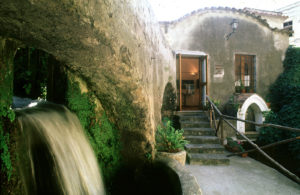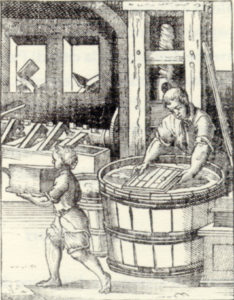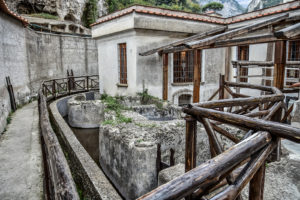Different authoritative historians have been submitted to support the theory that Amalfi was the first city that introduced this way of producing hand made paper. One of them, Matteo Camera, writes in his volume “Istoria della Città e Costiera di Amalfi”: “It is undoubtable that the production of writing paper, as well as on parchment as on bambagina, traces back to the XIII century and it has been one of the main industries of Amalfi for a long time.
 Without attempting to detract this theory, it’s important to mention that Amalfi develops it’s own and true paper industry with innumerable paper mills at short notice. This development has contributed to the fame of Amalfi as a paper producer in the entire world. Most paper mills were located at the Valle dei Mulini.
Without attempting to detract this theory, it’s important to mention that Amalfi develops it’s own and true paper industry with innumerable paper mills at short notice. This development has contributed to the fame of Amalfi as a paper producer in the entire world. Most paper mills were located at the Valle dei Mulini.
The suggestion valle (valley) has been described and praised by writers such as Henry Longfellow, and used by artists in different times. For example Pietro Scoppetta who used it for his water-colour paintings which are exposed at the prestigious Capodimonte Museum at Naples. In the beginning of the eighteenth century the writer Karl Friedrich points out: “The conductor of water rises along the declivity under the rocks which arches a cave or adherent the wall of the rock.
Often the riverbeds of the Valle dei Mulini, are covered by large pergola’s of vines. The last edge of the valley is occupied by a building composed by different floors where paper is produced. Across this valley runs the Canneto river. The sources rises from the Lattari mountains, which cross a series of underground canals which run parallel but distinctly to the natural run of the river, to start moving the machines necessary for the production.
The Golden Era
 Till so far the most interesting and most completed document on the existence of paper mills, can be found in the uncial register of landed property. This document from 1700 indicates the activity of 11 paper mills in the centre with a total capacity of 83 pile (tins made of rock in which rags were crushed to produce paper). Some of them were huge buildings with skimming (rooms with open windows and numerous fenditures used as drying up for the paper disposed on long lines). Others had a more moderate size. In the beginning old rags were used as production materials which came from Amalfi and other places.
Till so far the most interesting and most completed document on the existence of paper mills, can be found in the uncial register of landed property. This document from 1700 indicates the activity of 11 paper mills in the centre with a total capacity of 83 pile (tins made of rock in which rags were crushed to produce paper). Some of them were huge buildings with skimming (rooms with open windows and numerous fenditures used as drying up for the paper disposed on long lines). Others had a more moderate size. In the beginning old rags were used as production materials which came from Amalfi and other places.
An idea exists on the numerous tasks of papermakers provided by literature which describes payment in 5 cantari or tornesi (old measures) of wheat to the baronial customs of Amalfi.
The mills due to their geographical location, were subjects for damage caused by floods during the raining season and droughts in the summer. In the first case the water to use was accompanied with rubble and in case there was not sufficient water to let all the equipment operate at the same time, production had to be done in shifts. The complex and strong vicissitudes from historical, political and social point of view and even more important the upcoming industrialisation struck hard to this specific and other small paper mills in the Amalfi Coast. They were not able to maintain.
The decline
There are several causes due to the slow but progressive decline: the location of the small and narrow  Valle dei Mulini implied a lack of easy ways to communicate, due to the poor infrastructure, roads and railways. This caused also problems for the supply of prime materials and for delivery of the products. Competition with other and better equipped industries couldn’t be kept up. Furthermore there was the constant shortage of abundance of water from the river, a dominant factor for the feeding of the mills as well as the failing of modernisation of the equipment. These discouraging causes had forced several paper mills to stop their production.
Valle dei Mulini implied a lack of easy ways to communicate, due to the poor infrastructure, roads and railways. This caused also problems for the supply of prime materials and for delivery of the products. Competition with other and better equipped industries couldn’t be kept up. Furthermore there was the constant shortage of abundance of water from the river, a dominant factor for the feeding of the mills as well as the failing of modernisation of the equipment. These discouraging causes had forced several paper mills to stop their production.
 From this critical and difficult condition several employees write a petition to the King to ask for help. He replayed: “The tears of our children of our people have reached us …. Many machines which human usurp and had invented are the same ones which steal the bread out of the mouth of our loyal residents of our Kingdom”.
From this critical and difficult condition several employees write a petition to the King to ask for help. He replayed: “The tears of our children of our people have reached us …. Many machines which human usurp and had invented are the same ones which steal the bread out of the mouth of our loyal residents of our Kingdom”.
In spite of all difficulties, the papermakers of Amalfi continued their production with respect for the tradition. From generation to generation, from father to son meanwhile conserving the enterprise inherent in their character. The last and tremendous attack to the paper industry had been caused by a flood in november 1954. This flood had destroyed most paper mills. From the sixteen paper mills in the area only three remained. The Amalfi paper mills have never been and could have never been a huge or middle size industry but has from the beginning the artisan character which has remained till today.


